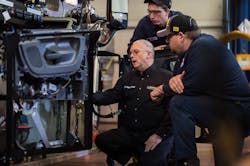Manager: Homer Hogg, technical development manager
Company: TravelCenters of America, operator of the TA and Petro chain of truck and travel stops
Operation: Some 3,000 technicians spread across 250 North American locations
PROBLEM:
Keeping maintenance technicians up to date on all the intricacies of today’s commercial trucks, trailers, and related components is a tough enough job. But when you’re talking about providing the latest know-how for most equipment makes and models to 3,000 technicians spread across 250 locations, that becomes as daunting a task as climbing Mount Everest without oxygen.
The trick is how to get that oxygen to the climbers in measured increments without interfering with their journey to the summit. At least that’s the way Homer Hogg looks at it.
“We operate 24/7, 365 days a year; we never close,” he says. “We offer a wide range of services on most trucks and trailers, on everything except internal work on engines, transmissions and rear-ends.”
TA’s technicians also perform warranty work for Daimler Trucks North America. “We’ve got a variety of diagnostic tools, codes, repair processes, and other information our technicians need to be constantly updated on,” Hogg points out.
Yet it’s not all book learning, he stresses, as a good bit of what technicians need to know must be transmitted in a hands-on fashion.
SOLUTION:
TA/Petro decided to establish three hands-on training centers at key points across the U.S. to serve its far-flung technician base: Phoenix, AZ; Nashville, TN; and Lodi, OH. Hogg says those three centers can train 1,500 to 1,700 TA/Petro technicians per year, which does not include the continual web-based training they must complete.
“The point of this is to reduce errors so our technicians get the repair right the first time,” he explains.
Each of the three training centers comes with its own unique history.The Lodi, OH, location, for example, is actually a former truck dealership purchased by TA/Petro and converted into a training facility.
The Nashville training site, however, came about following the devastating floods of 2010. When TA/Petro started rebuilding that location, it used that “reconstruction opportunity” to add a dedicated one-bay training site. “We even have a full-scale truck located there to provide about as realistic a hands-on environment as you can get,” Hogg points out.
Finally, the Phoenix location is a UTI Technical Institute facility within which TA/Petro rents space for its own dedicated technician training program.
“We really need that physical hands-on environment for training because there are just some things you cannot simulate,” Hogg says. “Now, sure, we use simulations for air conditioning and electrical systems laid out on big boards, but you often need real trucks in order to experience everything that will need to be done to complete a particular repair. There is just no substitute for that.”
About the Author
Sean Kilcarr
Editor in Chief
Sean Kilcarr is a former longtime FleetOwner senior editor who wrote for the publication from 2000 to 2018. He served as editor-in-chief from 2017 to 2018.
